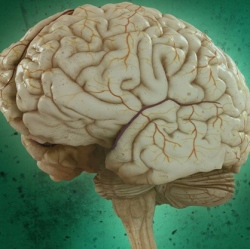
No methods currently exist for the early detection of Alzheimer’s disease, which affects one out of nine people over the age of 65. Now, an interdisciplinary team of Northwestern University scientists and engineers has developed a noninvasive MRI approach that can detect the disease in a living animal.
And it can do so at the earliest stages of the disease, well before typical Alzheimer’s symptoms appear. Led by neuroscientist William L. Klein and materials scientist Vinayak P. Dravid, the research team developed an MRI (magnetic resonance imaging) probe that pairs a magnetic nanostructure (MNS) with an antibody that seeks out the amyloid beta brain toxins responsible for onset of the disease. The accumulated toxins, because of the associated magnetic nanostructures, show up as dark areas in MRI scans of the brain.
This ability to detect the molecular toxins may one day enable scientists to both spot trouble early and better design drugs or therapies to combat and monitor the disease. And, while not the focus of the study, early evidence suggests the MRI probe improves memory, too, by binding to the toxins to render them “handcuffed” to do further damage.
“We have a new brain imaging method that can detect the toxin that leads to Alzheimer’s disease,” said Klein, who first identified the amyloid beta oligomer in 1998. He is a professor of neurobiology in the Weinberg College of Arts and Sciences. “Using MRI, we can see the toxins attached to neurons in the brain,” Klein said. “We expect to use this tool to detect this disease early and to help identify drugs that can effectively eliminate the toxin and improve health.”
With the successful demonstration of the MRI probe, Northwestern researchers now have established the molecular basis for the cause, detection by non-invasive MR imaging and treatment of Alzheimer’s disease. Dravid introduced this magnetic nanostructure MRI contrast enhancement approach for Alzheimer’s following his earlier work utilizing MNS as smart nanotechnology carriers for targeted cancer diagnostics and therapy. (A MNS is typically 10 to 15 nanometers in diameter; one nanometer is one billionth of a meter.)
